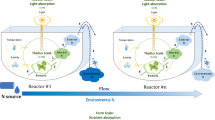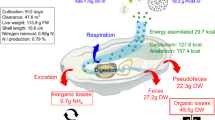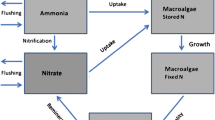Abstract
Key factors affecting the economic sustainability of any aquaculture industry and in particular the seaweed industry are its ecological interactions and impacts. Understanding these issues requires an extended production analysis and simulation, given the natural variability and dynamics of external factors that affect those interdependencies. As such, making sense of production data is required for suitable planning and resource optimization in a seaweed farm. The present work calculates the required water renewal rates for seaweed flow-through production units, using a novel simple user-friendly nitrogen budget model. The user interface is straightforward and the model parameter inputs and outputs are minimal, whereby the target users are commercial seaweed farmers. The model was parameterized for production kinetics of Ulva spp. based on an extensive literature survey, and was evaluated with published data on seaweed-growing experiments. Results for the estimated number of volume renewals per day are in agreement with the experimental data. The outputs indicate that this application can be used to estimate the envelope, i.e. average lower and upper ranges for water renewal rates for a given production in a given site. This model and corresponding parameterization for Ulva spp. are available to be used by farmers, managers and researchers in the form of a spreadsheet file (available as Supplementary Material). The conceptual model and application presented herein represent the basis for future developments to incrementally increase complexity, regarding additional seaweed species and production settings (in recirculating and integrated multitrophic aquaculture systems) by farmers and planners.







Similar content being viewed by others
References
Abreu MH, Pereira R, Yarish C, Buschmann AH, Sousa-Pinto I (2011) IMTA with Gracilaria vermiculophylla: productivity and nutrient removal performance of the seaweed in a land-based pilot scale system. Aquaculture 312:77–87
Ale MT, Mikkelsen JD, Meyer AS (2011) Differential growth response of Ulva lactuca to ammonium and nitrate assimilation. J Appl Phycol 23:345–351
Baghel RS, Trivedi N, Gupta V, Neori A, Reddy CRK, Lali A, Jha B (2015) Biorefining of marine macroalgal biomass for production of biofuel and commodity chemicals. Green Chem 17:2436–2443
Ben-Ari T, Neori A, Ben-Ezra D, Shauli L, Odintsov V, Shpigel M (2014) Management of Ulva lactuca as a biofilter of mariculture effluents in IMTA system. Aquaculture 434:493–498
Buschmann AH, Troell M, Kautsky N (2001) Integrated algal farming: a review. Cahi Biol Mar 42:83–90
Buschmann AH, Troell M, Kautsky N, Kautsky L (1996) Integrated tank cultivation of salmonids and Gracilaria chilensis (Gracilariales, Rhodophyta). Hydrobiologia 326:75–82
Castine SA, McKinnon AD, Paul NA, Trott LA, de Nys R (2013) Wastewater treatment for land-based aquaculture: improvements and value-adding alternatives in model systems from Australia. Aquac Environ Interact 4:285–300
Chopin T, Robinson SMC, Troell M, Neori A, Buschmann AH, Fang J (2008) Multitrophic integration for sustainable marine aquaculture. In: Jørgensen SE, Fathi BD (eds) Ecological engineering. Vol. 3 of Encyclopedia of Ecology. Elsevier, Oxford, pp 2463-2475
Chung IK, Beardall J, Mehta S, Sahoo D, Stojkovic S (2011) Using marine macroalgae for carbon sequestration: a critical appraisal. J Appl Phycol 23:877–886
Cohen I, Neori A (1991) Ulva lactuca biofilters for marine fishpond effluents. I. Ammonia uptake kinetics and nitrogen content. Bot Mar 34:475–482
Costa JC, Gonçalves P, Nobre A, Alves M (2012) Biomethanation potential of macroalgae Ulva spp. and Gracilaria spp. and in co-digestion with waste activated sludge. Bioresour Technol 114:320–326
del Río MJ, Ramazanov Z, García-Reina G (1996) Ulva rigida (Ulvales, Chlorophyta) tank culture as biofilters for dissolved inorganic nitrogen from fishpond effluents. Hydrobiologia 326:61–66
Droop MR (1983) 25 years of algal growth kinetics a personal view. Bot Mar 26:99–112
Duarte CM, Wu J, Xiao X, Bruhn A, Krause-Jensen D (2017) Can seaweed farming play a role in climate change mitigation and adaptation? Front Mar Sci 4:100. doi:10.3389/fmars.2017.00100
FAO (2014) Fishery and Aquaculture Statistics. Global production 2014. (FishStatJ). In: FAO Fisheries and Aquaculture Department online. Rome. Updated 2014. http://www.fao.org/fishery/statistics/software/FishStatJ/en. Accessed 26 Sept 2016
FAO (2016) The state of world fisheries and aquaculture 2016. Contributing to food security and nutrition for all. FAO, Rome, 200 pp
Fujita RM, Goldman JC (1985) Nutrient flux and growth of the red alga Gracilaria tikvahiae McLachlan (Rhodophyta). Bot Mar 28:265–268
Fujita RM, Wheeler PA, Edwards RL (1989) Assessment of macroalgal nitrogen limitation in a seasonal upwelling region. Mar Ecol Prog Ser 53:293–303
Gao K, McKinley K (1994) Use of macroalgae for marine biomass production and CO2 remediation: a review. J Appl Phycol 6:45–60
Grobbelaar JU (2004) Algal nutrition. In: Richmond A (ed) Handbook of microalgal culture: biotechnology and applied phycology. Blackwell, Oxford, pp 97–115
Hadley S, Wild-Allen K, Johnson C, Macleod C (2015) Modeling macroalgae growth and nutrient dynamics for integrated multi-trophic aquaculture. J Appl Phycol 27:901–916
Hafting JT, Cornish ML, Deveau A, Critchley AT (2015) Marine algae: gathered resource to global food industry. In: Sahoo D, Seckbach J (eds) The algae world. Springer, Dordrecht, pp 403–427
Kim JK, Kraemer GP, Yarish C (2015) Sugar kelp aquaculture in Long Island Sound and the Bronx River estuary for nutrient bioextraction associated with biomass production. Mar Ecol Prog Ser 531:155–166
Korzen L, Pulidindi IN, Israel A, Abelsona A, Gedanken A (2015) Marine integrated culture of carbohydrate rich Ulva rigida for enhanced production of bioethanol. RSC Adv 73:59251–59256
Mata L, Schuenhoff A, Santos R (2010) A direct comparison of the performance of the seaweed biofilters, Asparagopsis armata and Ulva rigida. J Appl Phycol 22:639–644
Matos J, Costa S, Rodriques A, Pereira R, Sousa Pinto I (2006) Experimental integrated aquaculture of fish and red seaweeds in northern Portugal. Aquaculture 252:31–42
Neori A (1996) The type of N-supply (ammonia or nitrate) determines the performance of seaweed biofilters integrated with intensive fish culture. Israeli J Aquacult 48:19–27
Neori A (2016) Can sustainable mariculture match agriculture’s output? Global Aquaculture Advocate August 18, 2016. http://advocate.gaalliance.org/can-sustainable-mariculture-match-agricultures-output/. Accessed 26 Sept 2016
Neori A, Chopin T, Troell M, Buschmann AH, Kraemer GP, Halling C, Shpigel M, Yarish C (2004) Integrated aquaculture: rationale, evolution and state of the art emphasizing seaweed biofiltration in modern mariculture. Aquaculture 231:361–391
Neori A, Cohen I, Gordin H (1991) Ulva lactuca biofilters for marine fishpond effluents. II. Growth rate, yield and C:N ratio. Bot Mar 34:483–490
Neori A, Shpigel M (2006) An integrated system for farming fish, seaweed and abalone. CAB International Aquaculture Compendium, Wallingford
Neori A, Troell M, Chopin T, Yarish C, Critchley A, Buschmann AH (2007) The need for a balanced ecosystem approach to blue revolution aquaculture. Environ Sci Policy Sust Develop 49:36–43
Nobre AM, Ferreira JG, Newton A, Simas T, Icely JD, Neves R (2005) Management of coastal eutrophication: integration of field data, ecosystem-scale simulations and screening models. J Mar Syst 56:375–390
Nobre AM, Robertson-Andersson D, Neori A, Sankar K (2010) Ecological–economic assessment of aquaculture options: comparison between abalone monoculture and integrated multi-trophic aquaculture of abalone and seaweeds. Aquaculture 306:116–126
Norziah MH, Ching CY (2000) Nutritional composition of edible seaweed Gracilaria changgi. Food Chem 68:69–76
Pedersen MF, Borum J (1996) Nutrient control of algal growth in estuarine waters. Nutrient limitation and the importance of nitrogen requirements and nitrogen storage among phytoplankton and species of macroalgae. Mar Ecol Prog Ser 142:261–272
Pedersen MF, Borum J (1997) Nutrient control of estuarine macroalgae: growth strategy and the balance between nitrogen requirements and uptake. Mar Ecol Prog Ser 161:155–163
Pereira P, Valente LMP, Sousa-Pinto I, Rema P (2012) Apparent nutrient digestibility of seaweeds by rainbow trout (Oncorhynchus mykiss) and Nile tilapia (Oreochromis niloticus). Algal Res 1:77–82
Radulovich R, Neori A, Valderrama D, Reddy CRK, Cronin H, Forster J (2015) Farming of seaweeds. In: Tiwari B, Troy D (eds) Seaweed sustainability—food and nonfood applications. Academic Press, London, pp 27–59
Robertson-Andersson D, Potgieter M, Hansen J, Bolton J, Troell M, Anderson RJ, Halling C, Probyn T (2008) Integrated seaweed cultivation on an abalone farm in South Africa. J Appl Phycol 20:579–595
Samocha TM, Fricker J, Ali AM, Shpigel M, Neori A (2015) Growth and nutrient uptake of the macroalga Gracilaria tikvahiae cultured with the shrimp Litopenaeus vannamei in an Integrated Multi-Trophic Aquaculture (IMTA) system. Aquaculture 446:263–271
Schuenhoff A, Shpigel M, Lupatsch I, Ashkenazi A, Msuya FE, Neori A (2003) A semi-recirculating, integrated system for the culture of fish and seaweed. Aquaculture 221:167–181
Sheehan J, Dunahay T, Benemann J, Roessler P (1998) A look back at the U.S. Department of Energy’s Aquatic Species Program—biodiesel from algae. National Renewable Energy Laboratory, Golden, Colorado. NREL/TP-580-24190, pp 1–328
Solidoro C, Pecenik G, Pastres R, Franco D, Dejak C (1997) Modelling macroalgae (Ulva rigida) in the Venice lagoon: model structure identification and first parameters estimation. Ecol Model 94:191–206
Troell M, Halling C, Neori A, Chopin T, Buschmann AH, Kautsky N, Yarish C (2003) Integrated mariculture: asking the right questions. Aquaculture 226:69–90
Troell M, Neori A, Chopin T, Buschmann AH (2005) Biological wastewater treatment in aquaculture—more than just bacteria. World Aquacult 36:27–29
Turpin DH (1992) Physiological mechanisms in phytoplankton resource competition. In: Sandgren (ed) Growth and reproductive strategies of freshwater phytoplankton. Cambridge University Press, Cambridge, pp 316–368
Valente LMP, Araújo M, Batista S, Peixoto MJ, Sousa-Pinto I, Brotas V, Cunha LM, Rema P (2016) Carotenoid deposition, flesh quality and immunological response of Nile tilapia fed increasing levels of IMTA-cultivated Ulva spp. J Appl Phycol 28:691–701
Valente LMP, Gouveia A, Rema P, Matos J, Gomes E, Pinto IS (2006) Evaluation of three seaweeds Gracilaria bursa-pastoris, Ulva rigida and Gracilaria cornea as dietary ingredients in European sea bass (Dicentrarchus labrax) juveniles. Aquaculture 252:85–91
Valente LMP, Rema P, Ferraro V, Pintado M, Sousa-Pinto I, Brotas V, Cunha LM, Oliveira MB, Araújo M (2015) Iodine enrichment of rainbow trout flesh by dietary supplementation with the red seaweed Gracilaria vermiculophylla. Aquaculture 446:132–139
van Iersel S, Gamba L, Rossi A, Alberici S, Dehue B, van de Staaij J, Flammini A (2009) Algae-based biofuels: a review of challenges and opportunities for developing countries. FAO, Environment, Climate Change and Bioenergy Division, Rome, 59 pp
Yarish C, Redmond S, Kim JK (2012) Gracilaria culture handbook for New England. Wrack Lines. Paper 72. http://digitalcommons.uconn.edu/wracklines/72. Accessed 26 Sept 2016
Acknowledgements
The authors are grateful to the two anonymous reviewers for valuable comments, which considerably improved this manuscript. Financial support was provided by the Portuguese Foundation for Science and Technology (FCT) as postdoc scholarship to Ana Nobre (SFRH/BPD/109442/2015).
Author information
Authors and Affiliations
Corresponding author
Additional information
Online version of the Sea++4AlgaePlanning: http://seaplusplus4.com/algaeplanning.html
Electronic supplementary material
ESM 1
(XLSX 140 kb)
Rights and permissions
About this article
Cite this article
Nobre, A.M., Valente, L.M.P. & Neori, A. A nitrogen budget model with a user-friendly interface, to assess water renewal rates and nitrogen limitation in commercial seaweed farms. J Appl Phycol 29, 3039–3055 (2017). https://doi.org/10.1007/s10811-017-1164-9
Received:
Revised:
Accepted:
Published:
Issue Date:
DOI: https://doi.org/10.1007/s10811-017-1164-9




